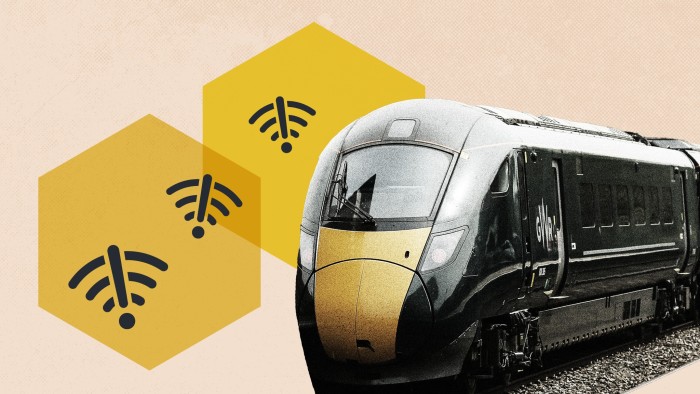Unlock the Editor’s Digest for free
Roula Khalaf, Editor of the FT, selects her favourite stories in this weekly newsletter.
Travelling on a high-speed European train recently, I achieved a life goal: I successfully logged on to the WiFi. For a few blissful minutes, I read the news and sent some emails. Then the connection cut out again.
Train WiFi is almost uniformly terrible. Train companies advertise the joys of on-board connectivity but, if you take them at their word, you are destined to refresh your browser pointlessly. Of course, the symbol on your laptop claims you are connected: it’s the hope that kills you.
Decades ago, we first barked apologetically into our mobile phones, “I’m on a train.” Now we still have to hammer out text messages to the same effect.
So what is missing? There are three basic challenges, says Federico Protto, head of the Italian operations of Cellnex, Europe’s largest operator of mobile towers. Trains move very fast (nearly 200mph for European high-speed services), they carry a lot of people who demand a lot of bandwidth and each metal carriage is a form of Faraday cage, difficult for mobile signal to penetrate.
What’s more, as mobile operators have built out their networks, they have focused on urban areas. Trains, which draw their WiFi from mobile signal, travel through rural areas with few antennas. After leaving London St Pancras, the Eurostar loses phone connection well before it enters the Channel Tunnel.
The solution involves more mobile towers. The faster you travel, the harder the handover from one tower to another. Cellnex calculates that good connectivity on high-speed trains would require a tower for every kilometre of railway track. This takes into account how much more bandwidth bored passengers would use if they could stream to their hearts’ content. For comparison, SNCF, France’s national train operator, says its WiFi — which limits how much passengers can stream — relies on one tower every 3km. Which may explain my recent inability to get online between Paris and Lyon.
There are different options for expanding coverage. One possibility, says Protto, is that one mobile operator builds all the towers, and that this is converted to WiFi using an antenna on the train roof. The other is that, instead of WiFi, all mobile operators build out their 4G and 5G networks along railway lines, and that passengers primarily use this, not any onboard WiFi.
On much of Japan’s Shinkansen bullet lines, the 5G coverage is so good that only tourists (without limitless mobile data) need the WiFi. However, Icomera UK, which provides train WiFi, says 4G and 5G alone will struggle to fix the problem, given the Faraday cage effect. It points out that countries with good signal, such as Sweden and Germany, also invest in onboard WiFi.
Another question is: who should pay for this? The London Underground has been rolling out 4G and 5G, funded indirectly by the UK’s mobile operators.
However, Europe’s operators may not want to pay to build towers, connected by fibre optic cables, along the entire rail network. Italy’s railways, for example, stretch over 10,000 miles.
Is there a case for the train operators to pay? Working internet connections could be a boon for long-distance train travel. Executives would be far more likely to sit on a train for four hours (London to Amsterdam), four-and-a-half hours (Paris to Zurich) or even six hours (London to Frankfurt), if they knew it was like working from a café. That would mean being able to reliably join Teams meetings or client calls, not just being able to hotspot intermittently via your phone. Some Shinkansen trains now have private cabins to facilitate video calls.
In Britain, in 2023, there was a push in the other direction. To save money, transport officials briefly looked into scrapping free WiFi on trains. They pointed out that passengers were more concerned about value for money and reliability than connectivity. The momentum has now swung towards more connectivity. Improving connectivity across Britain’s trains would cost roughly £200mn, estimates Icomera UK.
Meanwhile, Eurostar, whose WiFi relies on 3G and 4G signal because 5G is not available, says improving the service is a “focus” for this year. In Germany, the government is pushing “seamless 5G” on railways. It will start with the 280km Hamburg-Berlin route, along which Deutsche Bahn is planning to install 265 5G masts.
But be careful what you wish for. Imagine a world in which train passengers (especially the most self-important ones) could seamlessly log into their Zoom calls, or stream short videos without headphones. What are the chances people like me go from complaining that the WiFi doesn’t work to complaining that it does?
